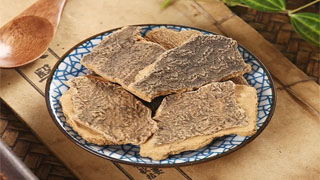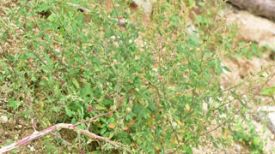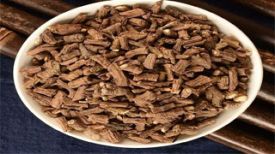
1. Alias
Chungen bark, Chubai bark, Kuchun bark, Ailanthus altissima, Chugen bark.2. Plant morphology
Deciduous trees. The bark is gray brown in color. Feathered compound leaves alternate, with small leaves measuring 13-25 centimeters in length, ovate lanceolate in shape, 7-12 centimeters in length, and 2-4.5 centimeters in width. The tip is gradually pointed, and the base is obliquely truncated. There are 1-2 pairs of coarse teeth near the base, and there is a gland on the back of the tooth tip. When crushed, there is a foul odor. Small flowers, green white in color, heterozygous, integrated with large terminal cone-shaped inflorescences; Sepals 5-6; 10 male stamens, attached to the base of the flower disk; The stamens of both sexes are relatively short, the pistil has 5-6 carpels, and the base is somewhat connected. The samara is flat, elongated and elliptical in shape, with 1-6 seeds attached to one stalk, and one seed in the middle of each samara. The flowering period is from April to July, and the fruiting period is from August to September.
3. Origin distribution
Wild or cultivated on mountain slopes, roadsides, residential areas, and village edges. Distributed in Hebei, Hubei, and most parts of the country.
4. Harvesting and processing
It can be peeled, dried, or scraped off to dry all year round.
5. Characteristics of medicinal herbs
Root bark: Irregular sheet-like or rolled sheet-like, varying in length and width, with a thickness of 0.3-1 centimeters. The outer surface is grayish yellow or yellow brown, rough, with many protruding longitudinal skin holes and irregular longitudinal and transverse cracks, and appears yellow white after removing the coarse skin; The inner surface is light yellow, relatively flat, and densely covered with shuttle shaped small holes or dots. Hard and brittle in texture, with granular outer layer and fibrous inner layer on the cross-section. Mild odor, bitter taste. Dry skin: irregular plate-like, varying in size, with a thickness of 0.5-2 centimeters. The outer surface is gray black, extremely rough, and has deep cracks
6. Sexual Taste Returning to the Classics
Cold in nature, bitter and astringent in taste. Return to the colon meridian, stomach meridian, and liver meridian.
7. Effect and Function
Clearing heat and dampness, stopping astringency, stopping diarrhea, and stopping bleeding. Belonging to the subcategory of clearing heat and dampness medicines, it is a type of heat clearing and dampness drying medicine.
8. Clinical application
Take 6-9 grams and decoct in water. Used to treat conditions such as red and white discharge, damp heat diarrhea, chronic diarrhea, rectal bleeding, and diarrhea.
9. Pharmacological research
Has anti-cancer and anti amoebic effects.
10. Chemical composition
Containing bitter ingredients such as Ailanthus altissima lactone and 11 acetyl Ailanthus altissima lactone, as well as fatty acids accounting for over 27%, plant sterols, invert sugars, wax alcohols, tannins, Ailanthus altissima ketone, bitter lignin, Ailanthus altissima lactone C, and β - Capolin derivatives.
11. Usage taboos
It is not suitable for those with spleen and stomach deficiency and cold, and it is also contraindicated for those with true yin deficiency in the kidney family who have collapsed, as it can only cause dryness. It is also not advisable to use it abruptly for those who have not yet accumulated qi.
12. Compatibility prescription
① Treatment of Trichomonas Vaginitis: Take 15g of Chunpi decoction in water. Add 30g of whole plant of Qianli Guang, 15g each of mint and snake bed seeds, boil in water, and wash outside. (Jiangxi Journal of Chinese Herbal Medicine)
② Treatment for cystitis and urethritis: 12g of fresh Chinese toon bark (45g) and 60g of fresh Plantago asiatica. Fry and serve. (Anhui Chinese Herbal Medicine)
③ Liver and spleen enlargement: Chunpi decoction. Spread the cloth on the affected area and change it once a day. (Anhui Chinese Herbal Medicine)
④ Treating joint pain: 30g of Ailanthus altissima root bark. Half of the drinks and one pig's foot. Stewed together. (Fujian Pharmaceutical Journal)
⑤ For those with damp heat in red and white discharge: 12 grams of Chinese toon bark, 9 grams of yellow cypress and Scutellaria baicalensis, and 15 grams of cockscomb and white clover. Boil it in water. (Huashan Medicinal Journal)
⊙ The content of the article is for clinical reference only. Non TCM professionals are not allowed to test drugs.


